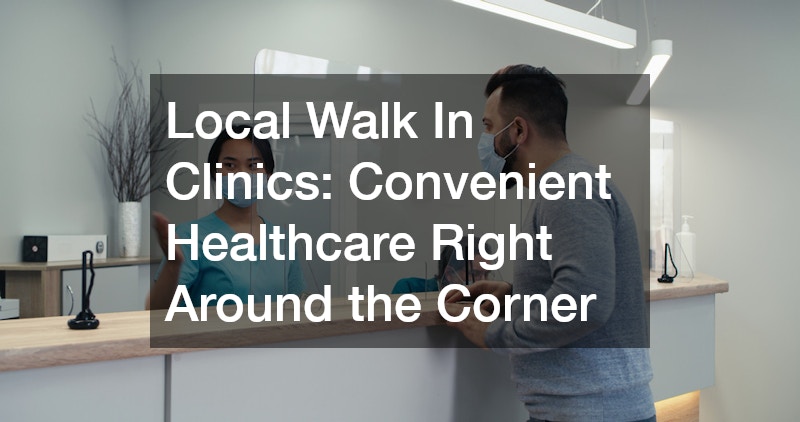Understanding the role and significance of local walk-in clinics in today’s healthcare landscape can provide clarity and options for many seeking medical attention. These clinics are integral in serving diverse communities with timely and accessible healthcare services. As a bridge between emergency rooms and traditional doctor’s offices, walk-in clinics represent a critical component of modern healthcare.
Primary Healthcare Services
Local walk in clinics offer a range of basic medical services that are crucial for maintaining general health. Patients can access services like physical exams, treatment for common illnesses, and minor injury care.
Their focus on primary healthcare makes them a convenient alternative for routine medical needs, eliminating the need for prior appointments.
By providing these fundamental services, walk-in clinics reduce the burden on emergency rooms and general practitioners. This accessibility ensures that even those with busy schedules or sudden healthcare needs can receive timely medical attention. Moreover, given the ease of access, these clinics often lead to earlier detection and management of potential health issues.
Specialized Care Options
Beyond primary healthcare, many walk-in clinics offer specialized services, which can include vaccinations, health screenings, and management of ongoing conditions. Such specialized care allows patients to address more tailored healthcare needs efficiently. Walk-in clinics often serve as a resource for preventative care, ensuring communities are well-protected against diseases.
Vaccinations are a pivotal service provided at these clinics, contributing to wider public health initiatives and personal immunizations. Health screenings at walk-in clinics can aid in early detection of conditions such as diabetes and hypertension. Additionally, these clinics can offer guidance and referrals for more specialized treatment if a condition requires attention beyond their scope.
Emergency vs. Non-Emergency Situations
One essential function of walk-in clinics is distinguishing between non-emergency and emergency care needs. While they are equipped to handle a variety of medical concerns, they are not substitutes for emergency rooms. Urgent or life-threatening conditions such as severe injuries, chest pain, or stroke symptoms require immediate attention in an ER.
Walk-in clinics are ideal for situations that need prompt attention but are not life-threatening. These include minor infections, mild injuries, and common illnesses like colds and flu. Understanding the appropriate situations for visiting a walk-in clinic can promote better healthcare choices and, consequently, more efficient use of emergency department resources.
Comparison with General Practitioners
Walk-in clinics differentiate themselves from general practitioners mainly through their accessibility and immediacy. Unlike traditional doctor’s offices that require appointments, walk-in clinics provide on-demand service. This setup suits individuals seeking immediate attention or those who wish to avoid scheduling hassles.
Another key difference is the operational hours; walk-in clinics often have extended service times, unlike the typical office hours of general practitioners. This flexibility allows patients to receive care outside the constraints of a conventional workday. As a result, they cater more effectively to urgent, but not emergency, health issues.
Patient experience at walk-in clinics is often characterized by shorter wait times for services. This efficiency appeals to those who may find long waits at traditional offices burdensome. However, it’s important to note that walk-in clinics usually do not provide the continuity of care that a dedicated general practitioner can offer.
Cost and Insurance Implications
The financial aspect of healthcare is a significant consideration for many when choosing where to seek care. Walk-in clinics typically offer a more cost-effective option compared to emergency rooms. They often provide transparent pricing and are lesser in cost than a visit to the ER for non-emergency situations.
Most walk-in clinics accept a variety of insurance plans, including private insurance, Medicare, and Medicaid. This broad acceptance ensures that a larger segment of the population can access these essential services. Patients without insurance can also benefit from the relatively lower rates compared to other healthcare settings.
Limitations and Challenges
Despite their benefits, walk-in clinics have limitations that can pose challenges for some patients. They may not be equipped to handle severe or complex medical issues, necessitating referral to specialized care or emergency services. Patients with chronic conditions requiring regular monitoring and consistent care might find general practitioners more suitable.
Another challenge is the potential lack of continuity in patient care, as walk-in clinics prioritise immediacy over long-term medical relationships. This can be a drawback for patients who rely on comprehensive medical histories for their treatment plans. Additionally, although costs are generally lower, unexpected fees can arise if certain services are not covered by insurance.
Future Trends in Walk-In Clinic Care
The future of walk-in clinics looks promising, with many facilities adapting to incorporate telehealth and digital healthcare solutions. This shift aims to meet the growing demand for convenient and accessible medical services. Providing remote consultations and electronic health records improves patient care and optimizes clinic operations.
Summarizing the benefits and considerations of utilizing local walk-in clinics for healthcare needs highlights their evolving role in health services. These clinics provide a convenient, accessible option for immediate and non-emergency care. As they continue to expand and innovate, walk-in clinics ensure they meet the changing demands of modern patients, enhancing the overall healthcare landscape.





